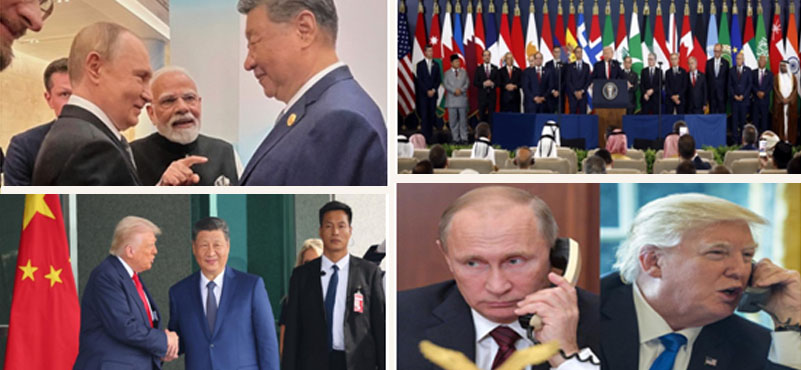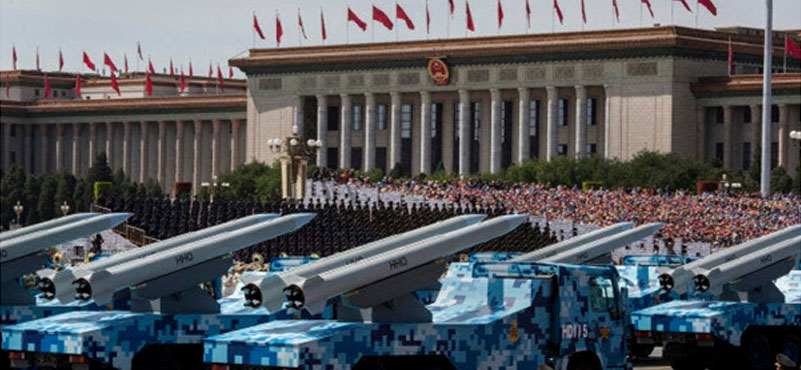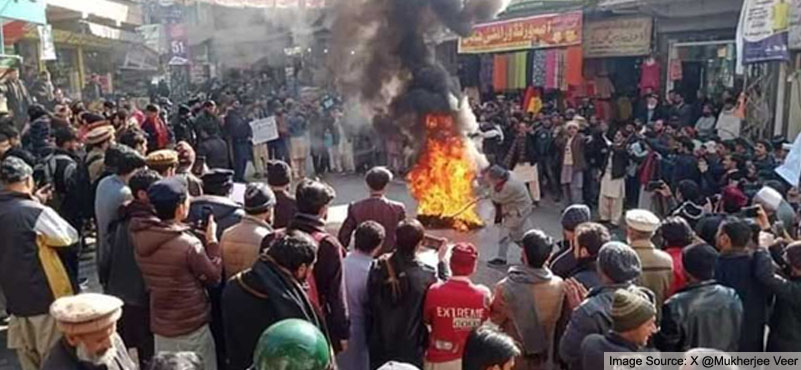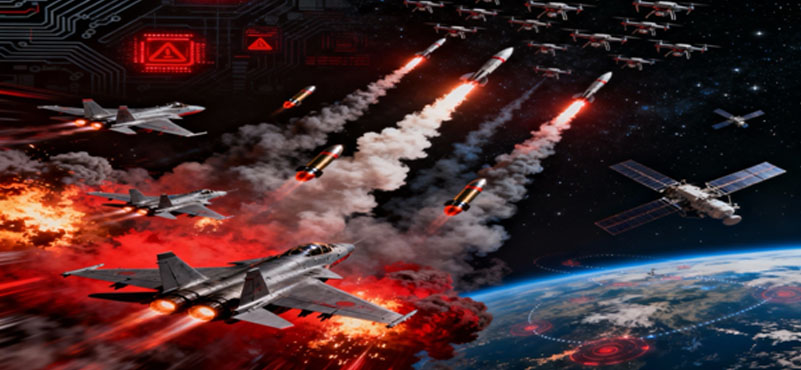Vladimir Len in in 1917 during the Russian Revolution had supposedly said “there are decades where nothing happens and then there are weeks when decades happen”. Given the prevailing pace and turbulence in global geopolitics, that quote appears an understatement. The refashioning of global economic, security and diplomatic discourse may have commenced before Trump assumed power in January 2025 but he seems to have imparted an unexpected, unpredictable and bizarre momentum where tweets precede pressers followed by tweets that undo all previous tweets and pressers. Following a unreasonable and cumulative tariff of 50% on India, which refused to relent, the SCO summit at Tianjin, characterised by close confabulations between Russia, India and China and tete e tete between Modi and Putin in the latter’s limousine raised global eyebrows of a potential reset against the West. Trump remarked, “Looks like we have lost India and Russia to deepest, darkest China”. Subsequent events overtime including Gaza Peace process, US and Russia flip flop on ceasefire in Ukraine, intensifying trade war between China and the US, drug war in Caribbean Sea and rare earth deals have diversified the geopolitical script.
State of The US
 Starting with the aim of making America Great Again, Trump’s perfunctory and belligerent policies on trade, immigration, federal funding and geopolitics may have triggered unprecedented internal and external turbulence within the US and in its relations with the outside world. The ‘No King’ protests by over 70mn in 2700 cities contesting unlimited and arbitrary powers of the President is a manifestation of the unpopular policies of the Trump dispensation. Growing unemployment, cost of living crisis covering housing, healthcare, groceries, gasoline and electricity bills have alienated the common American. The deployment of National Guard and marines in multiple US cities in aggressive immigration enforcement operations sans approval by local governments have undermined Trump’s approval rating to a dismal 36% , lower than lowest achieved by Joe Biden during his entire presidency. Reportedly 80 universities have closed down since 2020, accelerated in 2025 due to falling international students. Federal funding and enrolment of foreign students being made contingent to administrative alignment with Trump’s policies has strained higher education and triggered exodus of research scholars including noble laureates to Singapore.
Starting with the aim of making America Great Again, Trump’s perfunctory and belligerent policies on trade, immigration, federal funding and geopolitics may have triggered unprecedented internal and external turbulence within the US and in its relations with the outside world. The ‘No King’ protests by over 70mn in 2700 cities contesting unlimited and arbitrary powers of the President is a manifestation of the unpopular policies of the Trump dispensation. Growing unemployment, cost of living crisis covering housing, healthcare, groceries, gasoline and electricity bills have alienated the common American. The deployment of National Guard and marines in multiple US cities in aggressive immigration enforcement operations sans approval by local governments have undermined Trump’s approval rating to a dismal 36% , lower than lowest achieved by Joe Biden during his entire presidency. Reportedly 80 universities have closed down since 2020, accelerated in 2025 due to falling international students. Federal funding and enrolment of foreign students being made contingent to administrative alignment with Trump’s policies has strained higher education and triggered exodus of research scholars including noble laureates to Singapore.
The much acclaimed stoppage of wars lack both credibility, continuity and stability. The Gaza Peace Summit, signed with much fanfare in the presence of 20 world leaders, ironically without the two main protagonist, Israel and Hamas leadership appears to have meandered into a deadlock with Israel resuming bombing of Gaza resulting in over 200 killed and 600 injured since 10 Oct, in the garb of self-defence and lack of progress in handing over of remains of dead hostages. Hamas has assumed security control over Gaza City and is in no mood to disarm. Interestingly, the same countries including France, Italy, UK, Germany and much of the EU, which moved the resolution at the UN for an Independent State of Palestine, attended the Gaza summit where there was no mention of the Two State solution. Concurrently, the Board of Peace led by President Trump with the assistance of Tony Blair and Palestinian technocrats and the constitution of International Stabilisation Force are still to be streamlined. Despite more than deserved attention at the Summit, Pakistan is in no position to contribute troops with its own polycrisis in Baluchistan, Khyber Pakhtunkhwa, Punjab and volatile border with Afghanistan. Abject flattery and sycophancy has conditioned diplomacy in Trump’s era; starting from offer of a jet by Qatar (South Africa could not afford), minerals by Pakistan, golf themed golden gift package by Japan ( besides assured nomination for next nobel) and a golden crown by South Korea to soften the trade deals. With Trump seeking a hierarchical relationship rather than harmonious one, these can at best be transitory appeasement than long term goals. The Ukraine war has vacillated between territorial compromises by Ukraine, regaining lost territory with US intelligence, military support including Tomahawks and back to the freezing of battle lines and sanctions on Russian oil companies.
 The much publicised meeting between Trump and Xi Jinping at Busan at best resulted in a framework for future trade deal and postponing of reciprocal trade embargoes by a year. The contestations are unlikely to ebb anytime soon with US on a spree of rare earth deals with Australia, Malayasia, Thailand, Vietnam, Cambodia, Japan and South Korea besides Pakistan to claim its price reducing to $2 per kg. China is leveraging its monopoly (60% in extraction and 90% in refining) in the short term to secure its economic interests. The government shutdown in the US has entered the 30th day on 01 Nov with no end in sight. The so-called war against the drug lords in Venezuala (a la regime change operation) killing of 60 personnel in international waters, threat to Nigeria on prosecution of Christians and talk of resumption of nuclear tests are new areas of potential instability.
The much publicised meeting between Trump and Xi Jinping at Busan at best resulted in a framework for future trade deal and postponing of reciprocal trade embargoes by a year. The contestations are unlikely to ebb anytime soon with US on a spree of rare earth deals with Australia, Malayasia, Thailand, Vietnam, Cambodia, Japan and South Korea besides Pakistan to claim its price reducing to $2 per kg. China is leveraging its monopoly (60% in extraction and 90% in refining) in the short term to secure its economic interests. The government shutdown in the US has entered the 30th day on 01 Nov with no end in sight. The so-called war against the drug lords in Venezuala (a la regime change operation) killing of 60 personnel in international waters, threat to Nigeria on prosecution of Christians and talk of resumption of nuclear tests are new areas of potential instability.
State of China
Empowered by nearly three decades of double digit growth centred on capitalism, market oriented reforms and foreign direct investment, China emerged as the undisputed manufacturing behemoth of the world producing over 30% of global outputs. It has acquired unchallenged monopoly in rare earth processing, solar panels, EV batteries and steel. It exceeds the US in 57 out of 64 critical technologies (excluding the J36 sixth generation aircraft prototype and YJ20 hypersonic missile) as per Australian Strategic Policy Institute reports. Western dependency on trade, technology, critical raw materials and intermediaries on China, find it difficult to decouple in the short term. Notwithstanding the downward economic trajectory since COVID-19 due to severe criticality in the real estate, local government debt, tech and private sectors regulations and weak domestic consumption; even with a sub 5% economic growth forecast, China is unlikely to yield favourably to rival economies dictatorial terms. The US had to lick its wounds multiple times, first a dramatic climb down from 245% tariff to 30% and the recent 100% tariff to a one year moratorium. The internal turbulence within China however portend a grim picture.
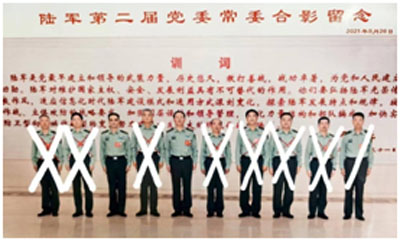 The large scale purging of senior leadership within PLA make it hesitant in pursuing its goal of seizing Taiwan by force or further belligerence across the LAC / South China Sea. Since 2023 it has sacked nearly 20% of senior leadership in PLA including nine sacked on 17 Oct 25. This includes two defence ministers and a Central Military Commission Vice Chairman. This has effectively neutralised the leadership, loyalty and morale required for a major invasion across a steeply contested strait.
The large scale purging of senior leadership within PLA make it hesitant in pursuing its goal of seizing Taiwan by force or further belligerence across the LAC / South China Sea. Since 2023 it has sacked nearly 20% of senior leadership in PLA including nine sacked on 17 Oct 25. This includes two defence ministers and a Central Military Commission Vice Chairman. This has effectively neutralised the leadership, loyalty and morale required for a major invasion across a steeply contested strait.
The reset in India – China relations since October 2024 after the violent clash at Galwan is not something unusual / unprecedented or accelerated by Trump’s anti India push. The two countries sharing a 3488 kilometres of disputed borders have a history of standoffs and clashes, generally restricted by use of less lethal weapons. These have been interspersed by relative peace through agreements, confidence building measures and military talks. The 1954 Panchsheel Agreement, restoration of diplomatic relations in 1976 after the border war, agreements in 1993, 1996 and more recently after the 2017 Doklam standoff with summits at Wuhan and Mamallapuram and after 2020 clash are examples. However, enhanced troops continue to remain deployed as on date. The tariff threat of US has found common grounds of solidarity.
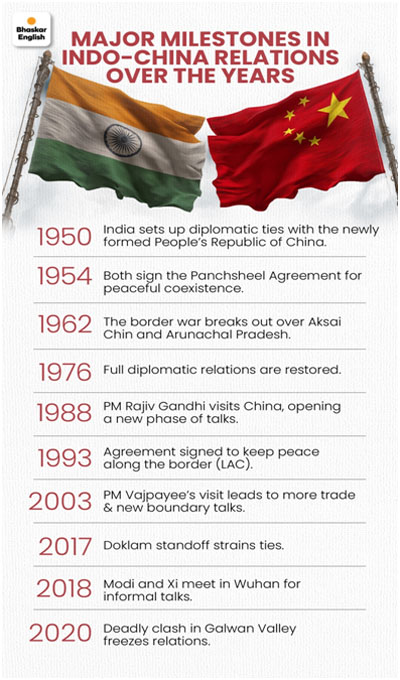 While the US is practicing isolationism, withdrawing from multilateral institutions like WTO and UNHCR, the Chinese, through the Global Governance Initiative is attempting to assume the role of a responsible player. At the APEC summit in Oct 25, Xi Jinping called for “joining hands” and “extending chains” rather than break or decouple supply chains. Canada has ended its eight year diplomatic and economic estrangement with China on the sidelines of APEC Summit with a visit to Beijing to follow.
While the US is practicing isolationism, withdrawing from multilateral institutions like WTO and UNHCR, the Chinese, through the Global Governance Initiative is attempting to assume the role of a responsible player. At the APEC summit in Oct 25, Xi Jinping called for “joining hands” and “extending chains” rather than break or decouple supply chains. Canada has ended its eight year diplomatic and economic estrangement with China on the sidelines of APEC Summit with a visit to Beijing to follow.
India’s Way Forward
Thus far, resilient India has been able to steadfastly and resolutely withstand US pressure refusing to sign a trade deal at gun point; pushing back repeatedly on protecting its farm sector and MSMEs, rejecting self-proclaimed intervention in India – Pakistan clash and assurance on cutting back import of Russian oil. It has more vigorously pursued independent trade deals with the UK,EU, Canada and Australia to diversify export destinations. As against cutting back on apple investment on iPhones, it has secured resilient FDI of Rs 50,000 crore in financial sector, over $15 billion Google investment on AI hub in Vishakhapatnam, Rs 15,000 crore Foxconn investment in Tamil Nadu and similar large scale investment assurances by Japan and EU.
Key drivers of future geopolitics are likely to be shaped by manufacturing (supply chains), energy self-sufficiency (fossil fuel versus renewables), data connectivity, reduce dependence on single markets, mobility of global workforce, big tech (consider the latest Amazon internet DNS blackout) and rare earths and minerals. Mr Syed Akbaruddin pointed out that India has to limit import dependency to about 25% on critical minerals (on a single country) to reduce vulnerability from coercive trade practices. India’s response has to be calibrated not captive to decline control and co-option. Indeed this 25 % dependency may be on reciprocal dependency on critical resources / technology. Atmanirbharta + Atma Raksha + Atma Vishwas are no more mere slogans but imperative to maintain freedom of choice bereft of coercion and compulsion.
India can’t trust US anymore; neither to counter balance China (not withstanding presumed sharing of intelligence for Yangtse push back in 2022) nor to restrain Pakistan (from Pakistan giving us only “lies and deceit” to “my friend Pak PM and Field Marshal”) if it doesn’t fulfil US strategic interests. The instances are many; from 123 nuclear agreement to membership of NSG to supply of G404 engines to transfer of technology. India can’t trust China either; from jettisoning agreement in 1993,1996, 2005 and 2012 to trigger a blood bath in Eastern Ladakh and continuing aggressive infrastructure development along the LAC. The recent reset is conditional for a favourable trade outcome for both sides. India nuanced PM’s Tianjin visit with bilateral Maritime Cooperative Activity (MCA) with Phillippines in August and a Malacca Strait Patrol(MSP) coordination with Singapore in Sep as guardrails to its Indo-Pacific Strategy. Can India trust Russia ? Well! to an extent, as it stood by it during critical times. Even this relationship has to be a contextualised with changing global strategy. Russia hiked refurbishment of INS Vikramaditya from $974 mn in 2004 to $2.3 bn in 2010, called for exercising restraint after Pahalgam attack and continues its oil and defence sales to Pakistan.
The upward trajectory in India’s economic growth is not an exercise in self-aggrandizement. It is validated repeatedly by both IMF and World Bank. India has undertaken over 600 development projects in 78 countries with a $32.02bn line of credit. Despite US sanctions and reduced exports, growth has remained robust and domestic expenditure resilient. UK has completed a trade deal eliminating 99% tariff lines for Indian exports. Trade deal with EU is expected by end of the year. The challenges will be multi domain especially security, economic and ideological. These will often be mutually contradictory rather than converging. Following a middle path will elicit criticism both within and from outside. The fine balancing act has so far yielded restrained and grudging appreciation; whether it is in the nuanced reaction against US claims of mediation in Indo-Pak conflict, purchase of Russian oil or strategic alignment with Israel while supporting the Two State Solution.
India’s way forward will constitute;
- multipolarity, pragmatic hedging while maintaining strategic autonomy, self-reliance in critical technologies, diversification of oil, trade, technology and defence equipment to maintain economic sovereignty.
- Secure critical supply chains, robust and resilient defence preparedness( including operationalisation of integrated theatre commands and joint logistics) along the Western and Northern borders.
- Management of neighbourhood through economic integration, connectivity and calibrated confidence building.
- India’s 32 mn diaspora is a potent instrument of soft power for strategic influence globally, besides remittances, business ownership and FDI. This must be integrated into the crisis communication and narrative management philosophy discussed recently.
- Internal cohesion through inclusiveness, consultation and accommodation.
India is NOT at a “Lagrange Point”, as Mr Shashi Tharoor mentions in his article in The New Indian Express on 05 Oct, meaning equidistant from US and China. India seeks its own space in the space with ever increasing gravitational pull.
ABOUT THE AUTHOR
 Major General SC Mohanty, AVSM (Retd), was commissioned in June 1983. The officer commanded a Mechanised Infantry Battalion, a Mechanised Brigade and an Infantry Division (RAPID Strike) in the Western Sector. As a Brigade Major, he took active part in the Kargil Operations while located at Drass. As part of Military Operations Directorate, he headed the Information Warfare, Cyber and Electronic Warfare branches. Post retirement, he was the Security Advisor to Government of Arunachal Pradesh from July 2020 to May 2023.
Major General SC Mohanty, AVSM (Retd), was commissioned in June 1983. The officer commanded a Mechanised Infantry Battalion, a Mechanised Brigade and an Infantry Division (RAPID Strike) in the Western Sector. As a Brigade Major, he took active part in the Kargil Operations while located at Drass. As part of Military Operations Directorate, he headed the Information Warfare, Cyber and Electronic Warfare branches. Post retirement, he was the Security Advisor to Government of Arunachal Pradesh from July 2020 to May 2023.

